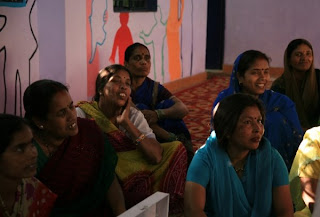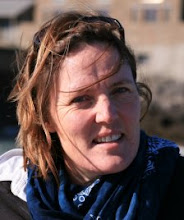Because I am spending most of my time in the slums with the children, I have not spent much time with the women. Although they are around each day to greet me on arrival, sometimes lingering at the door to watch a class and always there to say good-bye at the end of the day, we have only had brief conversations but nothing much more than that.
Today I had lunch with Anita and Sunita. Anita works for Asha in Jeevan Nager and has looked after me each day. Sunita heads up the Mahila Mandel (women’s group) in Jeevan Nager. I had been instructed to arrive early, so we headed for Sunita’s home soon after midday.
We had a great time, chatting and exchanging stories, with Anita translating as we chatted. As with other slum dwellings, Sunita’s home is small, with 2 rooms. Perhaps it is easier to describe it as a small rectangular building divided width ways in two. The first section is the entrance and kitchen, with a 2-ring gas stove and fridge. Water is stored in buckets on the floor; one clean for drinking and cooking the other for washing. The second room has a small double bed, cupboard and carpet on the floor. This is where she and her husband and 2 teenage sons sleep. The house is beautifully neat, cool and comfortable. The cool bit was because of a large fan “air conditioner” in the bedroom/living room. Our chats were held sitting cross-legged on the bed, three women, from different walks of life, talking about stuff. As we chatted Sunita started to prepare the vegetables for lunch and a few more women drifted in.
When I first met Sunita she told me of the difference Asha had made in their lives and how she barely spoke to the women in the area. Now she has prayer meetings at her home every Sunday and through the course of the day 50 – 60 people will stop by. She has applied for a bigger home, as she can’t host this many all at once. Her visitors are not only slum dwellers, but from homes in the area and beyond. People travel to pray with her and she travels to them if they have prayer requests. Not only is her home open to all who need her, she provides drinks and a light meal. I asked if she worked to pay for the food for the constant stream of visitors and she said that her work is for Jesus and that God provides. She says she has all she needs and is happy. We talked of her husband who is both supportive and generous. He gives her complete freedom to come and go as she pleases. While this may seem the norm to most of us, this is not the case in many homes here, where some women are forbidden to speak with others and have no freedom of movement separate from their husbands. Sunita’s husband supports her activities financially and by helping with house work and cooking.
It was great sitting chatting and I even had my nails filed and painted! Maybe strange to you chaps reading, but it’s fun to have a “girlie” afternoon sometimes. I have a few friends who get hold of my hands and ‘sort my nails out’ with some colour - not something I fuss with much. I now have sparkly pink nails, fingers and toes, (as we’re barefoot in the buildings) which were immediately noticed by my kids when I went to teach later!
Lunch was delicious, a large bowl of rice with a chili vegetable sauce. (Should I admit that I looked on with concern as they chopped the chilies – I should not have worried, as they prepared two versions of the same vegetable dish, the second with a fraction of the chilies.) I was interested to note that they used a pressure cooker. I think my mother is the only other person I have seen using one. Such a sensible vessel, only needing heat for a relatively short time, as they said, “lunch will be ready in no time” and it was!




